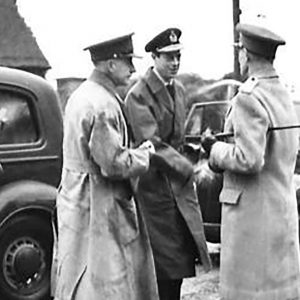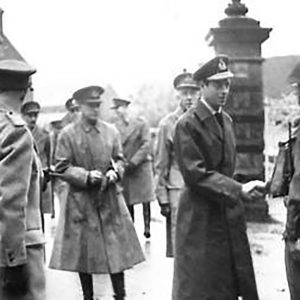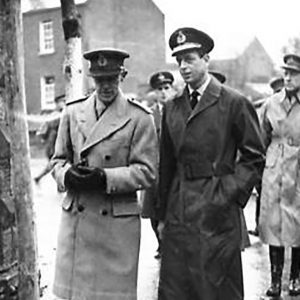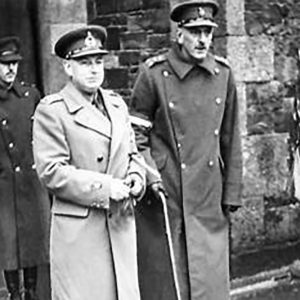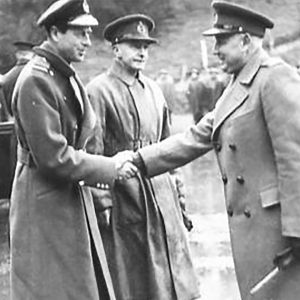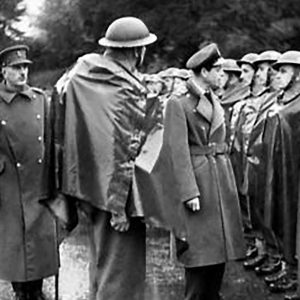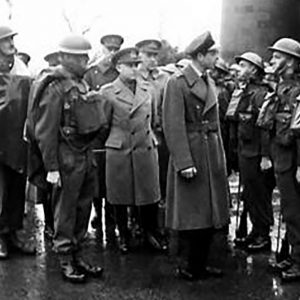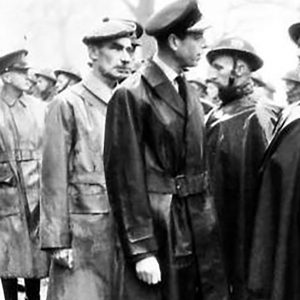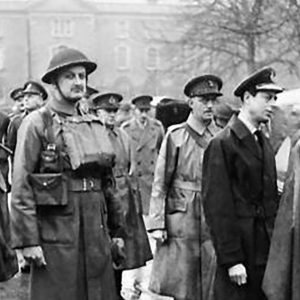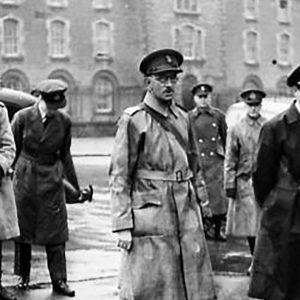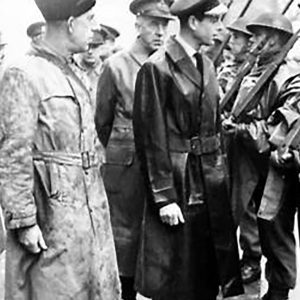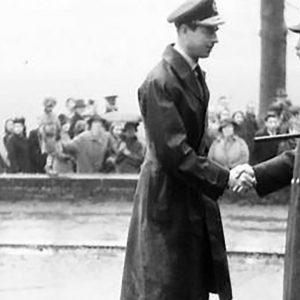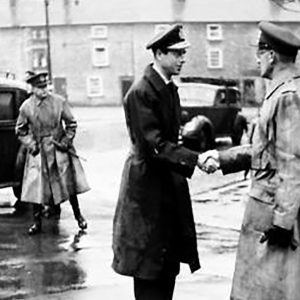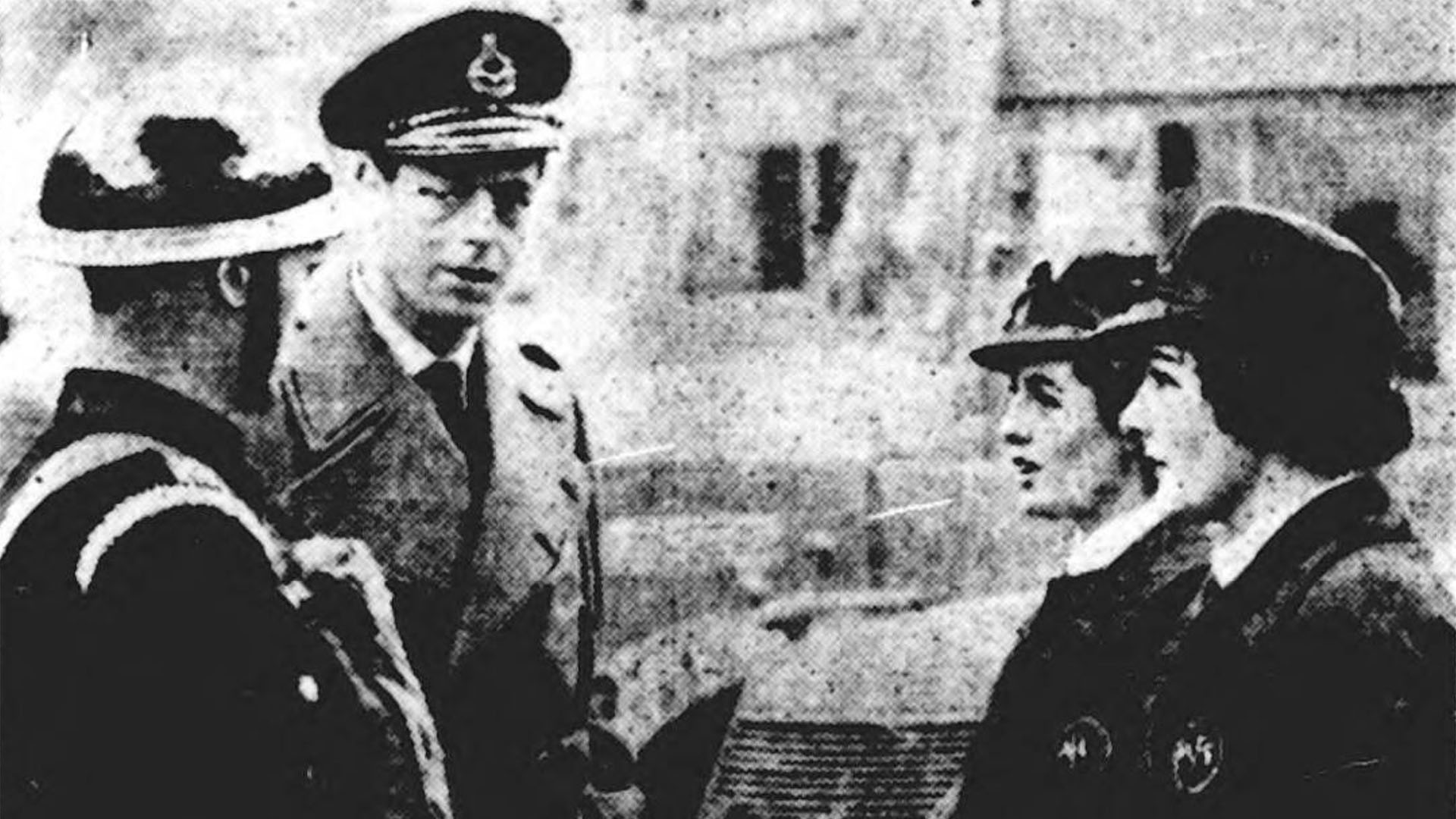Between 24th November 1941 and 29th November 1941, Prince George, Duke of Kent paid a visit to Northern Ireland. This was the third Royal visit to Ulster during the Second World War and was the Duke's second appointment in Northern Ireland in a little over a year.
The Duke and Duchess had been due to visit Northern Ireland in March 1939, a plan postponed as the Duke had become Governor-General of Australia. Prince George arrived in Ulster on 24th November 1941 to inspect British and Commonwealth forces based in the province. He was a guest of the Governor of Northern Ireland, the Duke of Abercorn at Government House, Hillsborough, Co. Down.
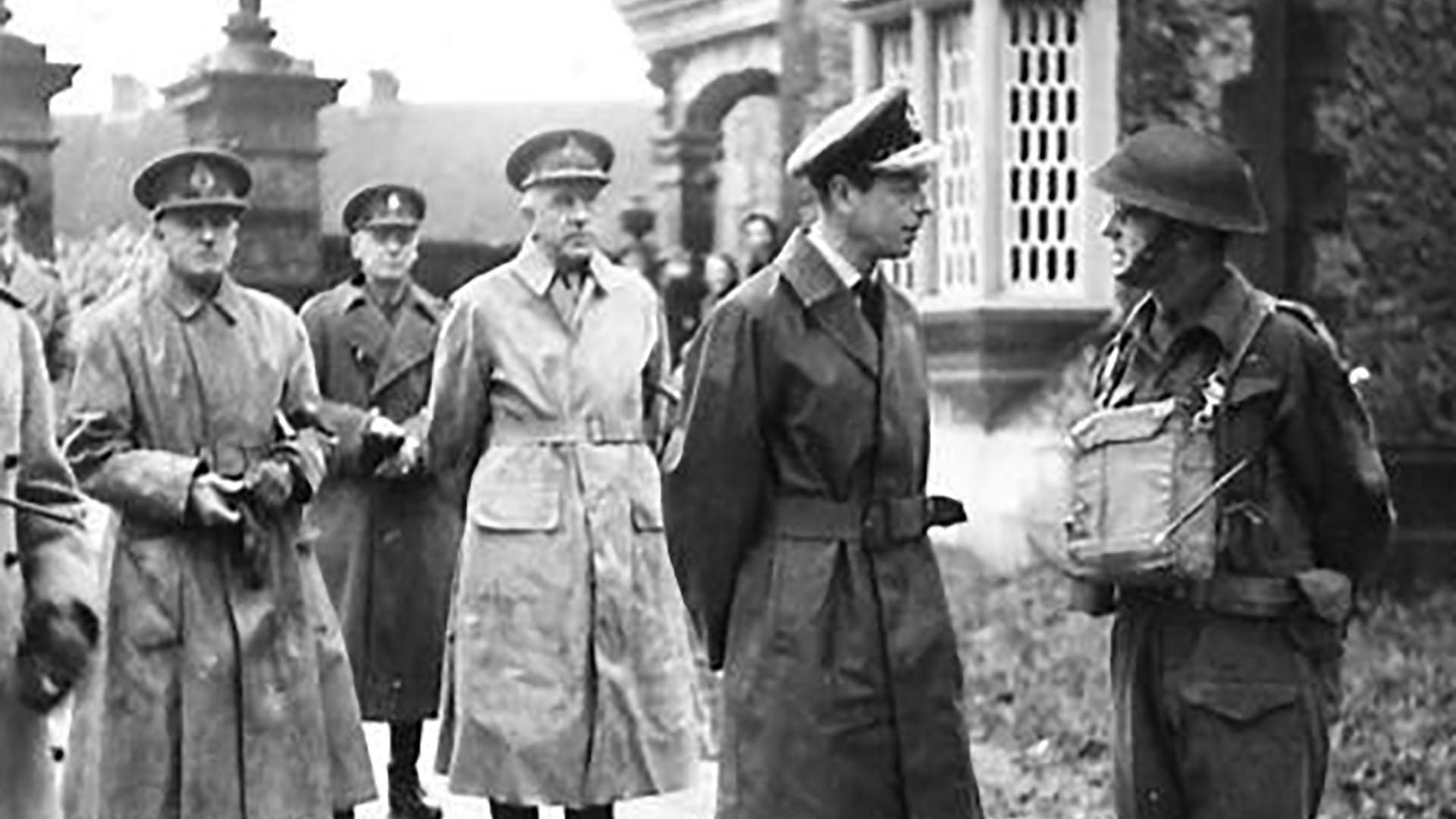
Imperial War Museum Photo: (H 15846) (Part of the War Office Second World War Official Collection). A conversation with a British Army Officer at Gosford Castle, Markethill, Co. Armagh during the visit of Prince George, Duke of Kent to Northern Ireland on 27th November 1941. Copyright Lieutenant J.R. Bainbridge - War Office Photographer.
25th November 1941
The Duke of Kent accompanied by Flight-Lieutenant Ferguson met with American workers who greeted him with a respectful “H’ya Duke”.
The Duke has been very keen and earnest in his inspection of service units. He took a full hour for an inspection of one Ulster parade of about six-hundred people. He spoke to practically every man and shook hands with each of the party of girls in the same parade.
Londonderry Sentinel – Wednesday 26th November 1941.
26th November 1941
The Duke arrived at The Guildhall, Derry/Londonderry on 26th November 1941. Dressed in his Royal Air Force uniform, he met with Mayor Senator Fred J. Simmons J.P. Prince George drove himself into the city having completed a 70-mile drive. There were many people on the streets although most were workers returning to their place of employment after lunch. Few paid attention to the Duke’s blue car on what was a surprise visit.
On pulling up to the Guildhall steps, the Duke of Kent met with Mayor Senator Fred J. Simmons J.P., the High Sheriff Councillor James Hamilton J.P., Town Clerk Mr. John C. Donnell, and other leading figures in the city. He was also welcomed by a group of American technicians employed in the city who waved their greetings from their passing vehicle. By then, a handful of curious people had gathered at the Guildhall to observe the visitor. The only sign of the importance of the visit was vases of chrysanthemums placed in the Guildhall vestibule.
A meeting in the Mayor’s Parlour saw the Duke and Captain H. de C. Martelli (representing the Governor of Northern Ireland) presented to the Mayor, the Mayoress, the Mayor’s daughter Mrs. McLaughlin, Mrs. H.P. Swan (a visitor from Buncrana, Co. Donegal), the Right Reverend Dr. Peacocke (Lord Bishop of Derry and Raphoe), Alderman Sir James Wilton, Alderman J.ames M. Mark, Councillor J.H. Welch, Councillor Samuel Orr, Councillor John Walker, Mr. A.J. Irwin (Chairman of the Londonderry Board of Guardians, and Captain Murray (County Inspector of the Royal Ulster Constabulary).
The Duke spoke with the Mayor emphasising the importance of the city’s role in wartime. By the end of the meeting, word had spread throughout Derry/Londonderry and a small crowd gave three cheers and sang the National Anthem on his departure.
While in Derry/Londonderry, Prince George inspected a detachment of WRNS. The Duke also spoke of him and the Dutchess receiving the Freedom of the City. This honour was due after the end of the Second World War but tragically the Duke of Kent died in an aviation accident in 1943.
27th November 1941
Co. Armagh was the next stop for the Royal visitor as he inspected British Military Forces based in the Orchard County. As well as inspecting troops, he took great interest in seeing the modern weapons and vehicles of mechanised units. As with the rest of the visit, the trip had been a closely guarded secret. As news of the Royal’s arrival spread, small groups of mainly women gathered at stopping places, the first of which was Lurgan, Co. Armagh. There, at just after 0900hrs, the Duke inspected a parade commenting that it was “a jolly good show”.
From Lurgan, the Duke made his way to Loughgall, Co. Armagh inspecting troops from 5th Reconnaissance Corps in full battle array at Loughgall Manor House.
He stopped and spoke to many of the men and often stepped behind them to go inside one of their vehicles and see what it contained and how it worked. Then he went on to where vehicles of an Ordnance Corps Mobile Section were drawn up. He inspected the men and paid great attention to the waggons closely packed with machinery. Some of the waggons were workshops in themselves.
Belfast Telegraph – Thursday 27th November 1941.
The Duke then walked along a tree-lined avenue and around a lake observing troops of an Anti-Tank Regiment of the Royal Artillery. He spent more than an hour in the village as well as visiting Gosford Castle, Markethill, Co. Armagh where he inspected 2/5th Battalion Lancashire Fusiliers, Royal Artillery troops, and met with Major-General James S. Steele.
In Armagh City, Co. Armagh, 91st Field Regiment, Royal Artillery lined up along The Mall. There, he also inspected the 2nd Battalion Royal Inniskilling Fusiliers. The Duke’s visit also included inspections of a 254th Field Company, Royal Engineers, and the Cameronians. He then had lunch in the Officers’ Mess with the Commanding Officer and other senior Army staff. On crossing into Co. Down, the Duke of Kent inspected further parades in Banbridge, Co. Down and Newry, Co. Down where a military band provided music.
28th November 1941
On 28th November 1941, the Duke of Kent visited Belfast taking in the City Hall, the bombed-out streets of East Belfast, a munitions factory, and a dockside canteen.
Did you see my face? Was I all right?
This was the question asked to her colleagues by a young female munitions worker after her meeting with the Duke. The Royal visitor was warmly welcomed by workers at the munitions factory, which was decorated with Union Flags and bunting. There, Sir basil Brooke (Minister of Commerce), the Right Honourable J.F. Gordon (Minister of Labour), the Right Honourable William Grant (Minister of Public Security), the directors of the firm, Sir Walter Smiles (Regional Representative of the Ministry of Aircraft Production), and Mr. J. Guthrie (Northern Ireland Area Officer for the Ministry of Supply) greeted the Duke.
Before leaving the munitions plant, the Duke paid tribute to the work of the Royal Ulster Constabulary. Several officers were presented to the Royal guest including Constable William Brett and Constable A. McCusker (George Medal recipients from the Leopold Street Barracks), and Sergeant Denis Cremin (British Empire Medal Recipient from the Springfield Road Barracks).
The next stop for the Royal visitor was an Auxiliary Fire Service Training School at Graymount House, Greencastle, Co. Antrim. There, he inspected a parade under the command of Chief Fire Officer, Mr. Ben White. The Duke then observed a fire drill display before meeting with Captain C.A. Hayes (Civil Defence Officer), Councillor Percival Brown (Chairman of the Civil Defence Authority), Mr. L. Brown, Mr. G. Murphy (Commandant of the Training School), Constable R. Moore, and Constable A. King of York Street Royal Ulster Constabulary. The crew who gave the fire drill and pump demonstration included A. Hyndman, J. Mulvey, J. Watson, J. O’Hara, P. Mooney of Dublin, and J. McDonald.
A visit also took place to the Royal Ulster Constabulary Barracks at Mountpottinger which doubled as an A.R.P Report Centre. There, along with the Right Honourable William Grant, Minister of Public Security, he met with Chief A.R.P. Officer Mr. F. Haslett, District Inspector Geelan, Major George Thomson, Chief District Officer of the Civil Defence Services, and Mr. J. Beattie M.P.
The Duke met with and congratulated 3 recipients of the British Empire Medal who had shown great courage during the Belfast Blitz. They were Nurse Denise Forster of the Civil Defence Ambulance Service, Mr. S Campbell, ambulance worker, and Messenger A.C. Hill.
By this time, news of the Royal visit had spread and when the Duke of Kent arrived in the Blitzed streets of East Belfast, thousand of people awaited. Everyone wanted to meet the Duke, exchange a few words, or even collect his authograph. The Royal visitor met people from all walks of life from Police Officers, A.R.P. Wardens, mothers and children, factory workers, and service personnel in uniform.
No one enjoyed it more than the Duke himself, for he was obviously delighted by the warmth of the welcome.
Belfast Telegraph – Friday 28th November 1941.
Accompanying the Duke on his visit was Commander Oscar Henderson (representing the Governor of Northern Ireland) and the Right Honourable William Grant, Minister of Public Security.
One of the first people to greet the Duke on the streets of East Belfast was Mrs. Evelyn Boyes. He also met Mrs. Margaret Toman of 86 Tower Street, Belfast who had endured the Blitz along with her 5 children. The Prince congratulated her on her “plucky spirit”. Another lady to meet the Duke was Mrs. Nellie McAllister of 83a Tower Street, Belfast who gave birth shortly after the 1941 air raids.
Small boys had the time of their lives. They climbed trees, lampposts, ladders, and anything else they could find including at least one tramcar, a bread cart, and a delivery van in their efforts to see all that was going on.
Belfast Telegraph – Friday 28th November 1941.
Children were at the fore of the crowd and the press gave a special mention to 13-year-old Florence Boyes who reached the Duke’s side 3 times in a quarter of an hour prompting the visitor to comment that she seemed to turn up everywhere. There was a jubilant feeling in the air, especially among those who had suffered during the Belfast Blitz.
As the Duke bade farewell to the crowds, a singalong began including ‘God Save The King’, ‘Land of Hope and Glory’, and ‘There’ll Always Be An England’.
After lunch at Stormont Castle, Belfast, the Duke in his role as President of the Royal National Lifeboat Institution presented medals and vellums to members of the Donaghadee and Newcastle lifeboat crews. Those awarded included Coxswain Samuel Nelson, Coxswain Patrick Murphy, and Motor Mechanic Robert Agnew.
The Duke’s busy day continued after lunch with an inspection of detachments of the Royal Navy and WRNS at Pollock Dock, Belfast. While in the area, he also visited H.M.S. Caroline and a dockside canteen whee Navy and Army personnel were playing table tennis and other games. The Duke also took time out to speak to some gathered shipyard workers nearby.
The day concluded with a short visit to the Officers’ Club at 69 High Street, Belfast. Honorary Secretary Mrs. M.B. Ramsay received the Duke. Also present was the Marchioness of Differin and Ava Mrs. Oscar Henderson, Mrs. Desmond Chambers, Mrs. Beatrice Doxford, Mrs. Haselden, Mrs. Howard Martin, Mrs. Graham Shillington, Miss Nadine Pryde, Mr. Ramsay, and Captain Fuge. Officers of all services attend the club and among those there at the time were Rear Admiral King, Air Vice Marshal Cole-Hamilton, and the Captain of a Canadian Corvette docked in the city.
Before his final departure from the city, the Duke visited Belfast City Hall where he signed the visitors’ book. There, he met with Lord Mayor Sir Crawford McCullagh and Alderman Dr. Williamson.
29th November 1941
With his inspection tour complete, the Duke of Kent departed from Government House, Hillsborough, Co. Down. He began his return to England to celebrate his 7th wedding anniversary with the Dutchess.
The Duke of Kent's Ulster Itinerary
References
- British Newspaper Archive
- British Newspaper Archive
- British Newspaper Archive
- British Newspaper Archive
- British Newspaper Archive
- British Newspaper Archive
- British Newspaper Archive
- British Newspaper Archive
- British Newspaper Archive
- British Newspaper Archive
- British Newspaper Archive
- British Newspaper Archive
- British Newspaper Archive
- British Newspaper Archive
- British Newspaper Archive
- British Newspaper Archive
- British Newspaper Archive
- British Newspaper Archive
- British Newspaper Archive
- British Newspaper Archive

